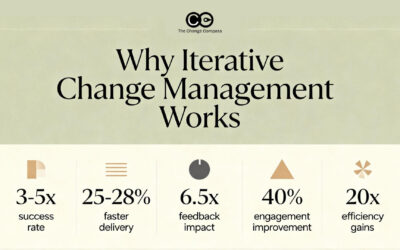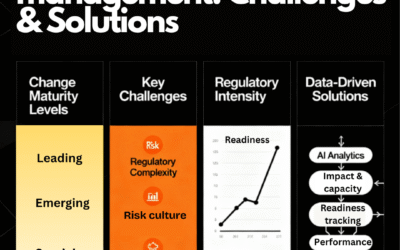In today’s dynamic business environment, marked by ongoing disruptions like environmental challenges, economic shifts, and the rapid advancement of AI tools, the pace of change demands that organizational agility and change readiness become critical capabilities for sustained competitive advantage and success. As businesses strive to remain competitive and responsive to ever-changing conditions, change practitioners play a pivotal role in designing and incorporating agility into their change planning and implementation efforts.
This article explores the importance of agility in creating an agile organization through effective organizational change management, drawing on research from industry experts such as McKinsey, and offers valuable insights for change practitioners to foster agility in their projects while building a change-ready workforce and navigating unpredictable business decisions, stakeholders, and environments.
The Significance of Agility in Change Management:
Agility has emerged as a key attribute for organizations seeking to thrive amidst disruption. McKinsey’s research on enterprise agility highlights the positive business impact achieved by companies that effectively embrace agility. These organizations demonstrate higher customer satisfaction, increased revenue growth, and improved employee engagement. By incorporating agility into their change initiatives, organizations can respond swiftly to market changes, capitalize on emerging opportunities, and mitigate risks more effectively.
Specifically, what this means is that imagine you are in a program of 5 projects over 2 years. All projects are working with a range of stakeholders within 2 divisions. There can be significant influence that your program can have on the work practices of these 2 divisions over a 2 year period. Now imagine incorporating agile practices in how you implement change. You now have the ability to really shift the dial for these work functions.
Designing Agile Change Management Strategies:
Change practitioners working on individual projects play a vital role in fostering agility within their organizations. To design and incorporate agility into change planning and implementation, practitioners should consider the following strategies:
- Embrace iterative approaches: This may sound like a no-brainer, but definitely start by incorporating agile principles into your project planning and delivery. By breaking down change initiatives into smaller, manageable increments, practitioners can iterate and adjust their strategies based on real-time feedback and evolving stakeholder needs. Not a lot of change practitioners do this well. A lot still follow the standard plan and execute approach without a lot of iteration and pivoting of tactics and approaches.
- Foster a culture of experimentation: Encourage stakeholders and team members to experiment with new ideas and solutions. Create a safe environment where psychological safety is prioritized, and setbacks are seen as learning opportunities, enabling continuous improvement and challenging the status quo of innovation. You may or may not have the luxury of being a part of a project team that promotes this environment. However, you can proactively set the expectation with your stakeholders and explain why this is valuable to help deliver a better change outcome.
- Encourage collaboration and cross-functional teamwork: Establish channels for open communication, collaboration, and knowledge sharing. Cross-functional teams can contribute diverse perspectives and expertise, enabling quicker decision-making and adaptability. This may sound like a generic corporate speak … team work and collaboration. However, you can easily design cross-functional teams, work processes and decision making forums to encourage this. The connection and collaboration across teams helps them to be more agile to understand different business forces and perspectives, avoiding ‘insular thinking’.
- Prioritize flexibility and adaptability: Recognize that change plans may need to be adjusted or revised as circumstances evolve. Build flexibility into the change management process, allowing for agility in response to unexpected challenges or opportunities. In every project, there are aspects that are different from other projects, even if you are involving the same stakeholders. Designing chuncked-down, flexible modules of change helps you to be more agile.

Remaining Agile as a Change Practitioner:
Change practitioners themselves must also cultivate transparency and agility to navigate the dynamic nature of their projects. Here are some key strategies for remaining agile:
- Embrace a growth mindset in your change approach: Adopt a mindset that values continuous learning, adaptability, and continuous improvement. Embrace new change tactics, methodologies, technologies, and tools that enhance your change management capabilities. Try new digital or automation solutions.
- Develop strong relationship-building skills: Cultivate effective relationships with stakeholders and maintain open lines of communication. Building trust and rapport enables better collaboration and facilitates agility in responding to shifting stakeholder needs. By doing this, you can have much more influence on your stakeholders.
- Stay informed and anticipate change: Continuously monitor industry trends, technological advancements, and organizational dynamics. Anticipate potential disruptions and proactively adjust your change plans to accommodate evolving circumstances. This requires strong business acumen.
- Foster personal resilience: Change management can be challenging, particularly when faced with unexpected changes. Develop personal resilience by cultivating emotional intelligence, stress management techniques, and the ability to adapt to new circumstances. To lead and influence your stakeholders you need to be their anchor.
In an era of ongoing disruptions and environmental challenges, agility has emerged as a crucial capability for organizations embarking on change initiatives. Change practitioners play a pivotal role in designing and incorporating agility into their change planning and implementation efforts.
By embracing iterative approaches, fostering a culture of experimentation, encouraging collaboration, and prioritizing flexibility, change practitioners can drive agility within their organizations. Additionally, by developing a growth mindset, nurturing strong relationships, staying informed, and fostering personal resilience, change practitioners can remain agile in the face of evolving business decisions, stakeholders, and environments. Embracing agility in change management is key to successfully navigating the ever-changing landscape of the digital world.
Images by Andy Mako.






